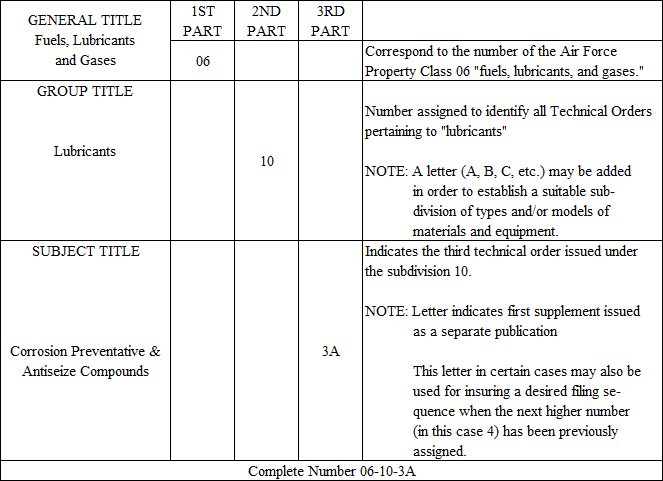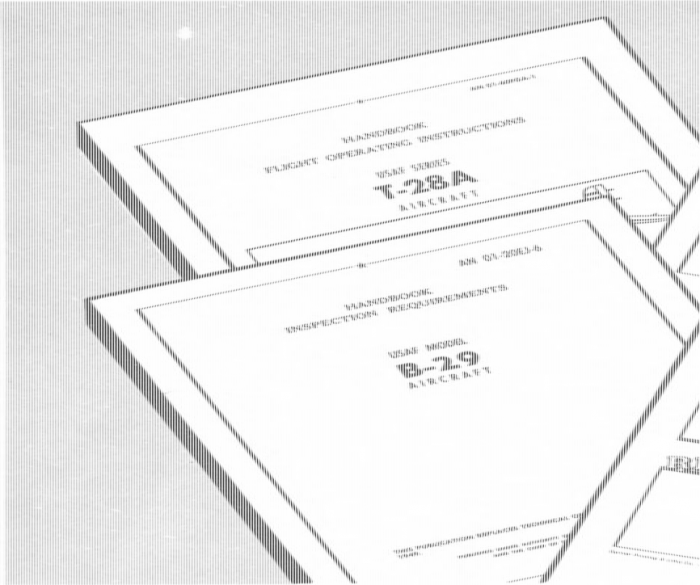Titles and Numbering SystemThe title of each technical order (other than
handbooks) and the numbering system conists
of three parts.
The first part of the title, known as the
general title, is that of the general Air Forces
property class of the equipment to which the
technical order pertains. For example, one
general title is Aircraft and Maintenance Parts
and another is Aircraft Engines and Mainte-
nance Parts.
The second part, known as the
group title,
is a further grouping of related subjects under
a main class group. For example, if the general
title is Aircraft and Maintenance Parts, the
group title will either be
general or it will be
the name of the contractor manufacturing
the equipment, such as Boeing, Bell, Republic,
or the like.
The third part, known as the
subject title,
indicates as precisely as possible the nature of
the contents and the particular equipment or
parts to which the order pertains. (For com-
plete assembly of title see table below.)
Attachment:
File comment: Technical Order Numbering System

For the purpose of identification, indexing,
and filing, technical orders are assigned num-
bers consisting of two or more parts, separated
by dashes. These numbers appear in the upper
right-hand corner of the first page of each
technical order and in the upper center of
each succeeding page.
The first part of the number normally cor-
responds to the number of the Air Force
property class concerned, except that the 00
series is established for indexes, for technical
orders pertaining to the subject of publications,
and for miscellaneous instructions which can-
not be otherwise classified. For example,
the number 06 is the first part of the number
of all technical orders pertaining to fuels,
lubricants, and gases; the Air Force property
class for fuels, lubricants and gases is 06.
The second part is a number assigned to
identify all the technical orders pertaining to
a particular subdivision (type, model, and the
like) of the general property class covered.
For example, under the general class 06, fuels,
lubricants, and gases, the number 5 is assigned
to all technical orders covering fuels; the
number 10 to those covering lubricants, and
so on. A letter may be added to the second part
of a technical order number in order that a
suitable subseries may be established for num-
bering different types of equipment, such as
bombardment or fighter aircraft. An addi-
tional letter (or letters) is sometimes added
in other that a more specific designation within
a subseries may be established in order that
publication numbers may be assigned to
particular models of equipment.
The third part of the number consists of
serial numbering, beginning with the number
1. In individual technical orders of each sub-
division of a general property class, a separate
series of numbers is used for each subdivision.
For example, under class 06 and subdivision 10,
all technical orders on lubricants are numbered
in the other of their issue, that is, 06-10-1,
06-10-02, and so on. When supplements are
issued as separate publications, they are
designated by adding a suffix letter to the
technical order number. For example, supple-
ments to T. O. 06-10-3 will be numbered
06-10-3A, 06-10-3B, and so on. Letter suffixes
may also be used for insuring a file location
adjacent to a particular technical order when
the next consecutive serial number has been
previously assigned.
NOTE: Some variation of the basic
numbering system exists in the dif-
ferent classes and subclasses of Air
Force property. A study of the 00-1 series
(index) will aid substantially in obtaining
a practical working knowledge of such
variations.
TYPES OF TECHNICAL ORERSTechnical orders are divided into four
general types - standard handbooks, parts
catalogs, time-compliance technical orders,
and miscellaneous technical orders. Publica-
tions in this group contain basic instructions
and information relating to operation, service,
repair and overhaul of Air Force aircraft and
equipment.
Aircraft HandbooksFor property class 01 (airplanes) the three
following basic handbooks are published for
each type, make, and model of airplane.
(-1) PILOT FLIGHT OPERATING INSTRUC-
TIONS. This handbook contains a complete
description of, and complete instructions for,
the proper operation of a particular type of
airplane. It is for the pilot's use and a copy
must be carried in the aircraft at all times.
The basic handbook for the B-29 is numbered
01-20EJ-1; the one for the T-6F is numbered
01-60F-1.
(-2) ERECTION AND MAINTENANCE INSTRUC-
TIONS. This handbook specifies the inspec-
tions to be performed, service instructions,
minor repair instructions, and tables of specifi-
cations which give important data on the
aircraft concerned.
(-3) STRUCTURAL REPAIR INSTRUCTIONS.
This handbook provides detailed instructions
for disassembly, inspect of parts, repair
and reassembly of the aircraft concerned.
(-4) PARTS CATALOG. This catalog lists
the parts numbers and complete nomenclature
of each part assembled in the aircraft con-
cerned.
NOTE: In addition to these four basic
handbooks, the (-5), Basic Weight Check
List and Loading Data is used as refer-
ence when applicable. For late-model
aircraft,a (-6) publication entitled Inspec-
Attachment:
File comment: Technical Order Types
 Technical Order Types.png [ 315.8 KiB | Viewed 5692 times ]
Technical Order Types.png [ 315.8 KiB | Viewed 5692 times ]
tion and Maintenance Requirements is
also published. This (-6) T. O. outlines
the intermediate and major inspection
requirements and contains data relevant
to procedures and manpower necessary
to keep the aircraft airworthy.
Engine HandbooksFor propery class 02 (engines), the three
following basic handbooks are published for
each type, make and model of aircraft engine.
No handbook (-1), Flight Operating In-
structions, is published for engines.
(-2) SERVICE INSTRUCTIONS. This hand-
book lists the special tools and gives instruc-
tions for servicing the engine.
(-3) OVERHAUL INSTRUCTIONS. This hand-
book lists all essential tools required and
gives instructions for disassembly, repair, and
reassembly of the engine concerned.
(-4) PARTS CATALOG. This catalog lists
the name and number of each part of a
particular engine in alphabetical and numer-
ical order and indicates the other engine
models with which each is interchangeable.
Equipment HandbooksEquipment handbooks, covering specific
items of airborne and ground equipment, are
issued to cover overhaul procedures, and when
necessary, to provide operating and service
instructions for these items. For example, a
T. O. on a certain type of starter or generator
will describe in detail the maintenance and
overhaul procedure for this item.





